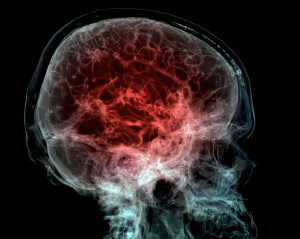Microplastics, plastic particles fewer than 5 millimeters in size, have infiltrated the environment at an alarming rate as worldwide plastic use increases.
微塑料是指尺寸小于5毫米的塑料顆粒,隨著全球塑料使用量的增加,它們以驚人的速度滲透到環(huán)境中。
Levels of microplastics found in the environment have surged in the past few decades, with current plastic production at more than 300 million tons annually, and an estimated 2.5 million tons floating in the world's oceans as of 2023, over ten times their 2005 levels.
過去幾十年,環(huán)境中的微塑料含量急劇上升,截至2023年,全球每年生產(chǎn)的塑料超過3億噸,其中約250萬噸漂浮在世界海洋中,是2005年水平的十倍以上。
A new study in Nature Medicine finds that microplastics and nanoplastics -- which are even smaller at 1 to 1000 nanometers in size -- accumulate at higher levels in the human brain than in the liver and kidneys.
一項(xiàng)發(fā)表在《自然醫(yī)學(xué)》上的新研究發(fā)現(xiàn),微塑料和更小的納米塑料(尺寸為1到1000納米)在人腦中的積累水平高于肝臟和腎臟。
The study also finds significantly higher concentrations of microplastics and nanoplastics in 2024 samples compared to 2016 samples, and higher levels in brains from people diagnosed with dementia.
研究還發(fā)現(xiàn),與2016年的樣本相比,2024年的樣本中微塑料和納米塑料的濃度顯著增加,并且在被診斷為癡呆癥的患者大腦中含量更高。
Although the study does not establish a cause-and-effect relationship between these plastic particles and dementia, it raises questions about the possible health consequences of exposure to plastics.
盡管這項(xiàng)研究并未確立這些塑料顆粒與癡呆癥之間的因果關(guān)系,但它引發(fā)了人們對(duì)塑料暴露可能帶來的健康影響的擔(dān)憂。
While scientists know these plastics are in our bodies, how they impact our health is unclear.
科學(xué)家們雖然知道這些塑料存在于人體內(nèi),但它們對(duì)健康的具體影響尚不明確。
"We think this is simply mirroring the environmental buildup and exposure," says study author Matthew Campen, professor of pharmaceutical sciences at the University of New Mexico. "People are being exposed to ever-increasing levels of micro and nanoplastics."
該研究的作者之一、新墨西哥大學(xué)藥學(xué)教授馬修·坎彭表示:“我們認(rèn)為這僅僅是環(huán)境積累的反映。人們正暴露在日益增加的微塑料和納米塑料中。”

Microplastics and nanoplastics (MNP) can be invisible to the naked eye and come from larger plastic products -- like soda bottles, shopping bags, and Styrofoam containers -- breaking down in the environment.
微塑料和納米塑料(MNPs)可能肉眼不可見,它們來源于更大的塑料制品(如汽水瓶、購(gòu)物袋和泡沫塑料容器)在環(huán)境中的分解。
Scientists have studied MNPs in the oceans since the 1970s.
自20世紀(jì)70年代以來,科學(xué)家們就開始研究海洋中的納米塑料。
Marine animals have been found to have microplastics in their bodies, absorbed from the water and from eating contaminated fish.
研究發(fā)現(xiàn),海洋動(dòng)物體內(nèi)含有微塑料,這些塑料來自水體以及食用受污染的魚類。
Microplastics also accumulate in the tissues of other animals that people eat like pigs, cows, and chickens.
微塑料還積累在人們食用的其他動(dòng)物(如豬、牛和雞)的組織中。
MNPs can end up in the air too: indoor air especially tends to contain more MNPs than outdoor air, due to shedding of particles from plastics in clothing, furniture, and household products.
納米塑料也可能進(jìn)入空氣中,尤其是室內(nèi)空氣,由于衣物、家具和家用產(chǎn)品中塑料顆粒的脫落,其MNPs含量往往高于室外空氣。
After we inhale these particles, they can travel through the body and end up in various organs.
我們吸入這些顆粒后,它們會(huì)通過身體進(jìn)入各個(gè)器官。
Studies have found MNPs in human lungs, placentas, blood vessels, and bone marrow.
研究已在人類的肺、胎盤、血管和骨髓中發(fā)現(xiàn)了納米塑料。
A 2024 study found evidence that MNPs can pass through the blood-brain barrier, a selective filter that controls what can enter the brain from the bloodstream.
2024年的一項(xiàng)研究發(fā)現(xiàn),納米塑料能夠穿過血腦屏障,這是一種選擇性過濾器,控制著哪些物質(zhì)可以從血液進(jìn)入大腦。
While it was previously thought only the smallest nanoplastics could pass the barrier, this study found larger microplastics can enter the brain too.
此前,人們認(rèn)為只有最小的納米塑料才能穿過這一屏障,但這項(xiàng)研究發(fā)現(xiàn),較大的微塑料也能進(jìn)入大腦。












